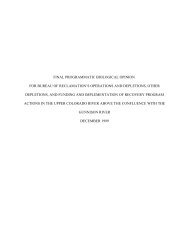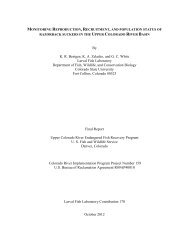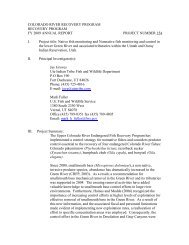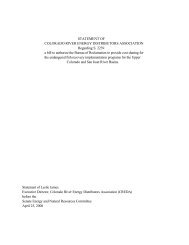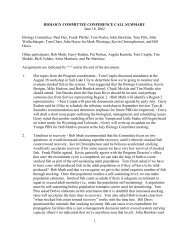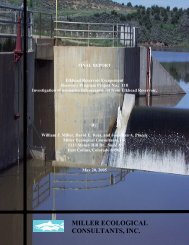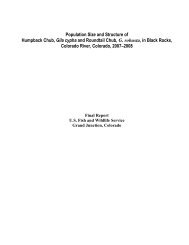riprap - Upper Colorado River Endangered Fish Recovery Program
riprap - Upper Colorado River Endangered Fish Recovery Program
riprap - Upper Colorado River Endangered Fish Recovery Program
You also want an ePaper? Increase the reach of your titles
YUMPU automatically turns print PDFs into web optimized ePapers that Google loves.
(U.S. <strong>Fish</strong> and Wildlife Service 1990b) identified the Green <strong>River</strong> in Desolation andGray canyons and in Dinosaur National Monument as important to recovery. Untilrecently, the Green <strong>River</strong> supported the last known riverine concentration of wildrazorback sucker (Lanigan and Tyus 1989; U.S. <strong>Fish</strong> and Wildlife Service 1998,2002d).3.1.2 <strong>Recovery</strong> Actions<strong>Recovery</strong> actions in the Green <strong>River</strong> have focused on refining the operation of FlamingGorge dam to enhance habitat conditions for the endangered fishes. A biologicalopinion was issued on the operation of Flaming Gorge Dam in 1992. This opinioncontained seasonal flow recommendations for the Green <strong>River</strong> at Jensen, Utah, andcalled for additional research under a specific set of research flows to collectinformation needed to refine the flow recommendations (particularly flowrecommendations for spring and winter) and to develop flow recommendations for otherareas of the Green <strong>River</strong>. The effects of the test flows on the endangered fishes andtheir habitat were evaluated through a variety of studies through 1997, and a final reportincluding revised flow recommendations was completed (Muth et al. 2000). NationalEnvironmental Policy Act (NEPA) compliance on reoperation of Flaming Gorge Damwas completed in 2006 with a Record of Decision executed in February. A newbiological opinion was completed in 2005. A study plan for the implementation andevaluation of flow and temperature recommendations for endangered fishes in theGreen <strong>River</strong> downstream of Flaming Gorge Dam was completed in 2007 (Green <strong>River</strong>Study Plan ad hoc Committee 2007). Following the 2006 Record of Decision,Reclamation provided peak flows that met or exceeded the Muth et al (2000)recommendations. Reclamation achieved these peak flow magnitudes and durationsby timing Flaming Gorge releases to match peak Yampa <strong>River</strong> flow, thus minimizingreleases needed to achieve the targets. A 2011 synthesis by Bestgen et al. showed thatafter 1993, releases occurred prior to larval razorback sucker drift and suggested thatthis approach may not be providing for successful razorback sucker recruitment. Inresponse, the <strong>Recovery</strong> <strong>Program</strong> proposed that Reclamation use the occurrence ofrazorback sucker larvae in channel margin habitats (an indication that larval drift isoccurring in the river) as the “trigger” to determine when peak releases should occurfrom Flaming Gorge Dam. A Larval Trigger Study Plan (Larval Trigger Study Plan adhoc Committee. In prep.), consistent with the Muth et al. (2000) flow recommendations,will be implemented for an experimental period of about six years beginning in 2012.Flow recommendations also have been developed for some tributaries to the Green<strong>River</strong>, such as the Yampa, White (interim flow recommendations), and Duchesne rivers.Tributary and mainstem flow recommendations will be carefully coordinated to addressrecovery needs from an <strong>Upper</strong> Basin wide perspective.An element of the 1992 Flaming Gorge Dam biological opinion identified the need toprotect dam releases from possible diversion in the occupied habitat of the endangeredfishes. The initial focus of this effort was to legally protect Flaming Gorge releases in15



